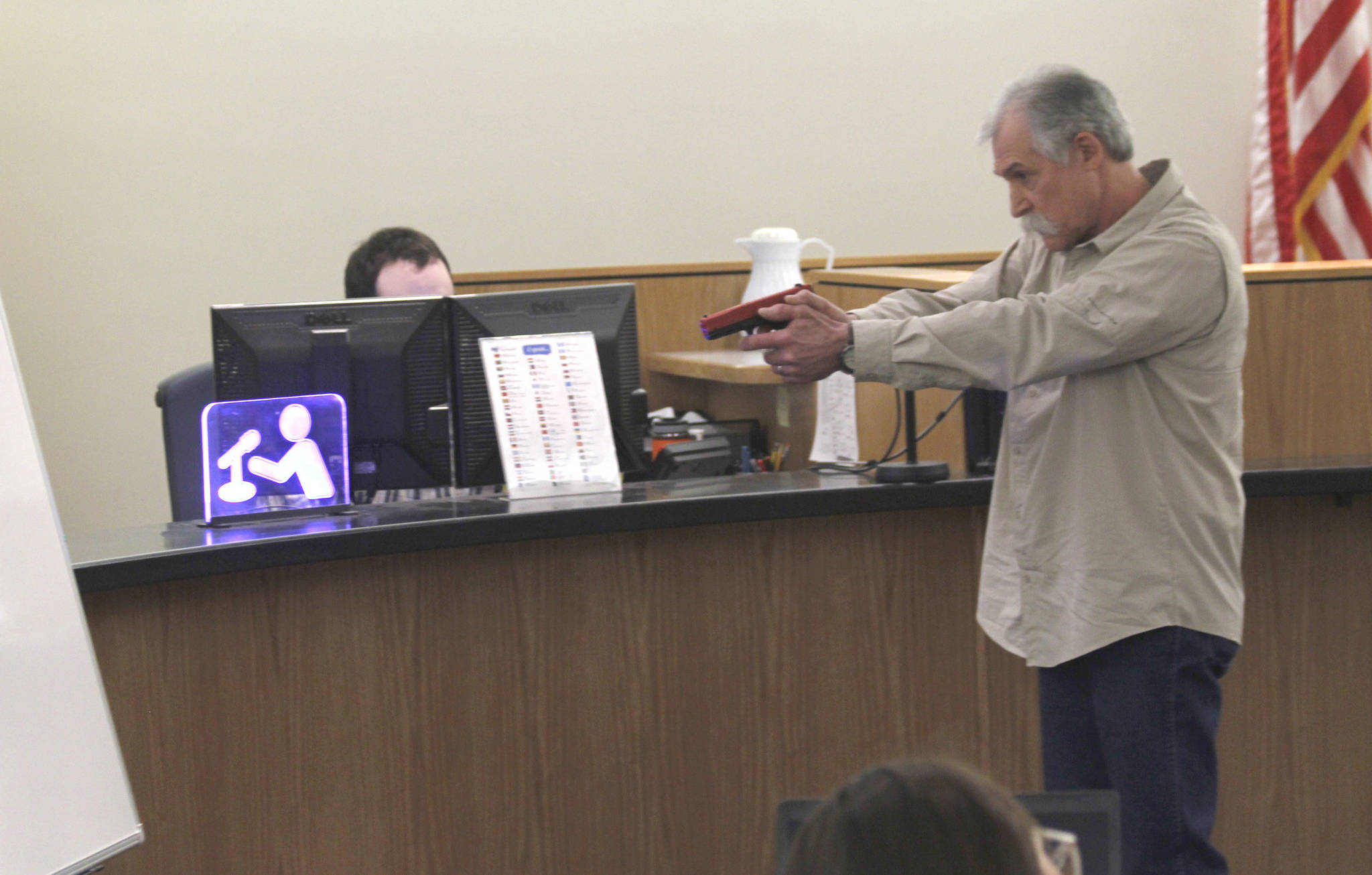Five words from an expert witness Tuesday brought the murder trial of Mark De Simone to a halt.
Chad Kendrick, a local firearms instructor and owner of Juneau gun and ammunition store Taku Tactical, was under direct examination from Assistant Public Defender Deborah Macaulay early Tuesday afternoon.
Kendrick did multiple demonstrations for the jury, regarding first how a person who is startled could unintentionally fire a gun and second about how a single-action revolver works and how it could unintentionally fire.
Macaulay then asked him if there’s a way the gun could accidentally fire a second time.
“Yes,” Kendrick said. “I’m afraid there is.”
Assistant District Attorney Amy Paige immediately objected and asked to have a conference with Judge Philip Pallenberg and Macaulay. This item was new to her, she later said, and it raised an important point.
[Find more details from the trial on our live blog]
A key part of Paige’s case against De Simone is that the victim — Juneau jeweler Duilio Antonio “Tony” Rosales — was found with two gunshot wounds in the back of his head during a hunting trip to Excursion Inlet on May 15, 2016.
Firing two shots with a single-action revolver (such as the Blackhawk revolver that investigators identified as the gun that killed Rosales) requires the shooter to cock the hammer, pull the trigger and then cock the hammer again and pull the trigger again, as multiple witnesses have testified in this case. These deliberate actions, Paige has argued, suggest the shooter did this purposefully.
Kendrick’s testimony Tuesday that there is a way for the gun to accidentally fire twice goes against Paige’s case.
But what upset Paige in court Tuesday is that she didn’t have a chance to have the prosecution’s firearm expert, Debra Gillis, do her own study into whether this could happen. If Macaulay had disclosed this part of the demonstration, Paige said, she could have had Gillis prepare to offer her findings.
This past Thursday, there was a walk-through of Kendrick’s demonstration after the jury had been dismissed for the day. Kendrick loaded his revolver with silicone bullets, cocked the hammer and pulled the trigger. The gun made a click, but nothing came out.
During that initial presentation, Kendrick did not go through the whole presentation he went through in court Tuesday, as Macaulay asked him to demonstrate how the hammer could slip and fire as someone looked into the chamber of the gun.
With the jury out of the room Tuesday, Kendrick did the rest of his planned demonstration for Pallenberg and Paige. It included him pulling the trigger and demonstrating that as a result of recoil and hand position, someone could accidentally fire the gun again.
Pallenberg was visibly frustrated and said he felt Macaulay had engaged in some “gamesmanship” by playing her cards close to the vest during last week’s walk-through. Macaulay said she doesn’t have to “spoon feed” her defense to the state. Pallenberg still said he believes Macaulay needed to provide more notice.
“It seems clear to me that there was an intent to hide the ball,” Pallenberg said.
Fortunately for Paige, Gillis (a forensic firearm and tool marks examiner for the Alaska Scientific Crime Detection Laboratory in Anchorage) happened to be in Juneau on Tuesday. Gillis doesn’t have much of an opportunity to conduct tests on a shooting range or in the crime lab in Anchorage, Paige said.
“Now here we are,” Paige said. “(Kendrick)’s already started testifying to it and the state has no meaningful way to respond.”
Pallenberg granted the prosecution a continuance, meaning Gillis will be given time to conduct her own study in response to Kendrick’s testimony. Gillis came to the courtroom Tuesday, and Kendrick did his demonstration for her. After court adjourned Tuesday afternoon, Gillis and Paige met to determine just how much time Gillis will need to do her own study.
They’ll inform Pallenberg of their time estimate Wednesday morning, and Pallenberg told the jury to come in a little bit later than usual. Pallenberg said he doesn’t want to make the jurors wait any longer than they already have during this trial, which is now midway through its third week.
Another issue Kendrick raised Tuesday is that the gun involved in the case — a Ruger .41 Magnum Blackhawk revolver — was made in 1972 and has not been properly updated.
He explained that with this kind of gun, to examine the cylinder (like to see if the gun is loaded) you have to pull the hammer halfway back. To put the hammer back down, he demonstrated, the person has to cock the hammer fully back, then put pressure on the trigger and then ease the hammer back down. This can result in the hammer slipping and hitting the firing pin, which fires the gun.
Kendrick said there was an update to this gun that put a bar between the hammer and the firing pin. The specific gun in this case, Kendrick said, was not updated.
• Contact reporter Alex McCarthy at 523-2271 or amccarthy@juneauempire.com. Follow him on Twitter at @akmccarthy.

